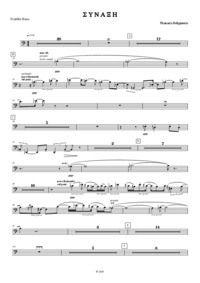- Έκφραση (αυτοτελές έργο)
- Μουσική Δωματίου
- 2009
- Φλάουτο - Αριθμός εκτελεστών: 1 | Όμποε - Αριθμός εκτελεστών: 1 | Κλαρίνο - Αριθμός εκτελεστών: 1 | Κρουστά - Αριθμός εκτελεστών: 1 | Μαντολίνο - Αριθμός εκτελεστών: 1 | Κιθάρα - Αριθμός εκτελεστών: 1 | Άρπα - Αριθμός εκτελεστών: 1 | Βιολί - Αριθμός εκτελεστών: 1 | Βιόλα - Αριθμός εκτελεστών: 1 | Βιολοντσέλο - Αριθμός εκτελεστών: 1 | Κοντραμπάσο - Αριθμός εκτελεστών: 1
- Μουσική δωματίου
-
-
Το παραπάνω ποίημα δίνεται από τον συνθέτη στο προλογικό σημείωμα της παρτιτούρας και συνοδεύει το έργο, πλαισιώνοντας προγραμματικά τον τίτλο του. Το έργο φαίνεται να βασίζεται σε μια πολυμελωδική υφή με μεταβλητό βαθμό πυκνότητας ανάλογα με τον αριθμό και το ηχόχρωμα των οργανικών μερών που συμμετέχουν στη μουσική "σύναξη". Η συνολική αισθητική του πρόταση φαίνεται να παραπέμπει στην αυτοσυγκράτηση και την ισορροπία που συνδέονται με το ήθος της βυζαντινής εκκλησιαστικής μουσικής (εξ ου και ο τίτλος του). Στην ίδια μουσική παράδοση φαίνεται να παραπέμπει και η φθογγική οργάνωση του έργου, με τη συχνή χρήση μικροτόνων και μικροδιαστημάτων να παραπέμπει στις μελωδικές έλξεις της βυζαντινής ψαλμωδίας. Οι μικροτόνοι που επιλέγει, δηλαδή την αλλαγή κατά 1/8 του αρχικού τόνου, κυριαρχούν στο κούρδισμα της άρπας, της κιθάρας και του μαντολίνου, όπως το ορίζει ο συνθέτης με συγκεκριμένα σύμβολα αλλοιώσεων στο εισαγωγικό σημείωμα της παρτιτούρας. Εφαρμόζονται επίσης επιλεκτικά στο φθογγικό υλικό των υπολοίπων οργάνων, κυρίως διαποικίλοντας δομικούς φθόγγους, γεγονός που παραπέμπει σε βυζαντινά ακούσματα.
-
The above poem accompanies the work, progrmatically framing its title (Synaxari=Assemblage). The work seems to be based on a polymelodic texture with varying degrees of thickness according to the number and timbre of the instrumental parts that participate in the "assemblage". Its overall aesthetic seems to allude to the restrain and balance associated with the ethos of Byzantine church music (hence its title), as does its pitch organization, with the frequent use of microtones hinting towards the melodic "attractions" (elxeis) of Byzantine chant. The microtones he chooses, i.e. the 1/8 change of the original pitch, dominate the tuning of the harp, guitar and mandolin, as defined by the composer with specific symbols of alteration in the score's introductory note. They are also applied selectively to the sound of the other instruments, mainly by transposing structural phonemes, which is reminiscent of Byzantine sounds.
-
- Ψηφιακή Βιβλιοθήκη και Ιδρυματικό Αποθετήριο του πανεπιστημίου Μακεδονίας
- Πανεπιστήμιο Μακεδονίας


